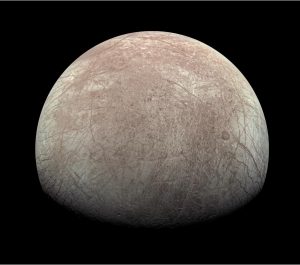
The CAESAR mission to collect a sample from a comet
“I’ve built my career on designing instruments you could put on the top of a rocket,” says Steve Squyres, Principal Investigator for the CAESAR mission. “But these all pale in comparison to what you can do in the laboratory.”
In December last year, CAESAR was selected as one of the two finalists for the NASA New Frontiers Program: the series of “medium-class” planetary exploration missions with a price tag in-between the Discovery and Flagship Programs. It is a category littered with familiar names, such as the New Horizons mission to Pluto and the Kuiper Belt, the Juno mission to Jupiter and the asteroid sample-return mission, OSIRIS-REx.
CAESAR’s romanesque acronym stands for Comet Astrobiology Exploration SAmple Return. It is a mission to explore the origins of the Solar System by collecting material from a comet to bring back to Earth.
The time required for a round-trip and the dangers of sample retrieval make such missions far more challenging than their counterparts which analyse in space. But the quality of that analysis in both today’s laboratories and with future instruments can make the results well worth the risk. A clear example of this are the lunar samples returned from the Apollo program, which are now being analysed by instruments not invented (and by scientists not yet born) when we visited the Moon in the 1960s – 1970s.
The selection of CAESAR is being keenly followed at ISAS/JAXA, as our team are designing the sample-return capsule that will deliver this cargo safely back to the Earth’s surface. It is a mission that fits both our interests with sample return from projects such as Hayabusa2 and the Martian Moon eXploration (MMX) mission, and also our scientific focus on understanding how water moves through the Solar System.
Icy messengers
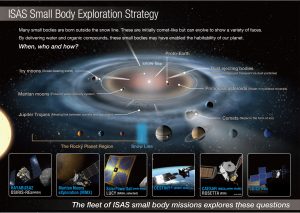
Unlike the asteroids, comets are heavy in easily evaporated compounds such as ices. It is these volatiles that vaporise as the comet passes close to the Sun and produce the distinctive tail that earned these objects the Greek name for “long hair”. The obvious abundance of volatiles makes comets a likely delivery service for bringing water and other biological necessities into the dry inner Solar System. A comet sample could therefore reveal how life on temperate rocky planets such as the Earth begun. The challenge is that this requires collecting the first comet sample of both non-volatile and volatile material.
CAESAR is a fourteen year mission, with a planned launch date of August 2024, a 4 – 5 year operation in the vicinity of the comet and then a return journey that delivers the sample back to Earth in 2038. The travel time is one of the mission’s biggest challenges, as the sample must remain pristine and unaltered during the seven year journey back to Earth.
“You might think you just want to bring the sample home,” Squyres warns. “The problem is that if you have a comet sample sealed up tight for seven years, chemistry will happen. Bad chemistry.”
Stored in a single container, the comet water vapour will react with the solid portion of the sample and alter the material before it can be analysed on Earth. To return a piece of comet successfully to the laboratory, the CAESAR team must therefore design a system to keep the volatile and non-volatile components separate.
The container to bring back a comet
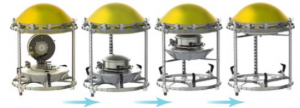
At the heart of the CAESAR design is therefore a dual chamber sample containment system. Material will be collected with a pneumatic sampler, which uses a pressurised gas stream to drive the top layers of comet soil into a central container. The sample will be gathered when the comet is far from the Sun, so that the spacecraft will not need to land in the thick fog of the comet’s vaporising coma. However, once the sample is safely stored, the container will be warmed to temperatures similar to what the comet experiences when it is closest to the Sun. This causes the volatiles to vaporise and travel through valves to condense in a cooled outer reservoir. When the valves close, the volatiles and non-volatiles are separately stored.
To ensure no trace volatiles remain behind to damage the non-volatile sample, the central sample container is allowed to vent to space for the journey back to Earth. Several days before we reach our home planet, all the valves close to prevent contamination and the container is pushed up into the heat shield of the sample return capsule, ready for atmospheric re-entry.
“There’s a mini laboratory within the capsule,” exclaims Kazuhiko Yamada, the engineer designing the CAESAR Sample Return Capsule (SRC) at ISAS as he describes the dual chamber sample container. The SRC must protect the sample container from when it leaves the spacecraft until it can be collected on the Earth’s surface.
“Our design will be based on the Hayabusa sample return capsule, but we must modify this to fit the requirements for CAESAR,” Yamada explains.
These modifications are significant. The capsule for CAESAR is around three times the size as that on Hayabusa2 as it must safely encase the complex and weighty sample containment system. The capsule design must also be able to open very wide to allow the non-volatile position of the sample to vent into space during the journey back to Earth. The long journey poses a problem for all aspects of the spacecraft, as the electrical components must remain reliable until the end of the 14 year mission.
As the SRC drops through the Earth’s atmosphere, the compressed air will shock heat in a process known as “aerodynamic heating”. Without the capsule heat shield, the sample will be burnt up before it reaches the Earth’s surface. The heat shield will be a made from the same ablation material as that successfully used by the predecessor to Hayabusa2, which returned to the Earth in 2010. In the final part of the descent, the now scorching heat shield will be jettisoned to prevent the accumulated heat from soaking back into the capsule. A two-stage parachute system will slow the CAESAR capsule for a soft landing in Utah in the USA.
A famous comet
When the sample container is opened, scientists will be able to study a sample from an object that has filled our news feeds for the last few years. CAESAR aims to collect a piece of comet 67P/Churyumov-Gerasimenko; the duck-shaped space rock that was the destination of the ESA Rosetta mission. It was a journey that made space history when Rosetta’s accompanying lander, Philae, touched down on a comet surface for the first time in 2014. Rosetta studied the vapours of the comet coma until the mission ended in a planned collision with the comet in 2016.
The selection of this familiar target for CAESAR is not coincidental. The mission aim to be the first to return both volatile and non-volatile cometary material to Earth is a difficult science and engineering goal and a familiar landscape is a huge help.
Data from Rosetta has enabled the CAESAR team to tailor the design of the sample collection system to the particle sizes and cohesion of the comet surface. Even possible landing sites can be discussed in advance of the launch, although the team will have to be careful of any changes that comet 67P may have experienced in its journey around the Sun. Such tuning is usually impossible for a mission to such a small and distant body, allowing the CAESAR team to greatly minimise the danger induced by unforeseen surprises. CAESAR therefore carries an extensive set of cameras to aid with sample collection, but no science instruments. This has enabled the mission to fit within the New Frontiers strict budget, despite the advanced sample containment system.
The lack of science instruments does not worry Tomoki Nakamura from Tohoku University and lead for the Japanese members of the CAESAR science team. For him, returning both the volatile and non-volatile cometary material to analyse in the laboratory is the key to discovering the conditions at the very start of the Solar System.
“Cometary minerals and volatiles have been preserved from the birth of our Solar System,” he explains. “This material retains the information on the very early stage of our Solar System formation.”
Such early conditions are relevant to how life begun on our own planet. Dust grains that rain down from comets to Earth are expected to contain organic molecules that are needed by life, such as amino acids and nucelobases. But the question in Nakamura’s mind is how did these form? One option is that they are built within the comet itself during chemical reactions with the watery part of the comet’s ingredients. The second option is that these form even earlier in the Solar System’s history and are accreted onto the comet as it forms.
Being able to examine the whole comet system in the form of both the volatile and non-volatile components will allow scientists to unpick what reactions happen in the comet kitchen, and what must have occurred even earlier at the start of the Solar System’s history. This knowledge can help map how the basic ingredients for life travel through a planetary system, affecting if and where we might find life on another world.
“There’s no substitute for the ground truth,” Squyres confirms, when comparing the potential results from examination of the comet vapours to a sample collected from the comet’s ice and rock nucleus.
“Rosetta successfully told us about surface morphology and the major components of the ices,” Nakamura adds. “But at the moment, only laboratory analysis can acquire the information about the early stage of our Solar System.”
The selection to chose between the finalists for the New Frontiers program will happen next summer in July 2019. Before that, the CAESAR team across the world have a lot of work to do!
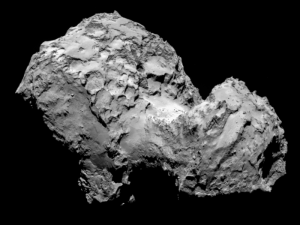
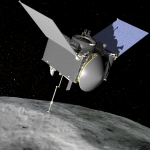 Previous Post
Previous Post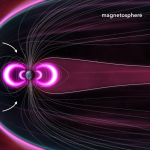 Next Post
Next Post

